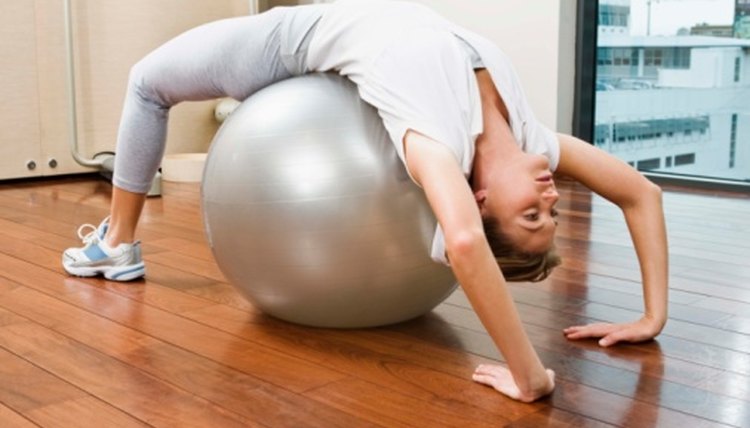How Much Air Should Go Into an Exercise Ball?

Exercise balls, often called stability balls, are oversized, rubber balls filled with air. These beach-ball-resembling contraptions effectively work your trunk, which according to the American Council on Exercise, can improve your posture, balance and movement awareness. The balls come in several different sizes, which you select based on your height. After purchasing an exercise ball, you will need to inflate it. The amount of air you put in your ball depends on its size.
Ball Sizes
Exercise balls used in gyms and homes are available in three main sizes. The size refers to the diameter of the inflated ball. A small ball is 55 cm, a medium ball is 65 cm and a large ball is 75 cm. Specialty exercise balls used in physical therapy and rehabilitation environments are also available in a 30 cm size and a 45 cm size.
Choosing a Size
Select the size of an exercise ball based on your height. The American Council on Exercise, or ACE, a non-profit fitness organization, recommends choosing a 55 cm ball if you are between 5 feet, 1 inch and 5 feet, 7 inches tall. Use a 65 cm ball if you are between 5 feet, 8 inches and 6 feet, 2 inches tall. If you are over 6 feet, 2 inches, choose a 75 cm ball. However, not all ball manufacturers use these same sizing guidelines. If you are 5 feet, 6 inches tall, SPRI, like ACE, recommends a 55 cm ball, but Gaiam recommends a 65 cm ball.
Inflation Tips
Inflate your exercise ball to its proper size. If you purchase a 55 cm ball, you should inflate it to a diameter of 55 cm. Make a pencil mark on a wall at the height your ball should be: 55, 65 or 75 cm. Inflate the ball until its top is level with the mark. Do not over-inflate your ball, because it may burst.
Considerations
Since the sizing chart for exercise balls is not consistent across the industry, you may need to adjust the inflation level of your ball slightly. After you inflate your ball as described above, sit on it with your feet flat on the floor. Your knees should be level with your hips. If your knees are higher than your hips, the ball is too small. If your knees are lower than your hips, it is too large. Adjust the amount of air in your ball as needed. If you need to significantly over- or under-inflate your ball to get the proper position, buy a different size ball.
Explore In Depth
References
- American Council on Exercise: Strengthen Your Abdominals With Stability Balls
- Gaiam Life: Top 10 Balance Ball, Exercise Ball & Stability Ball FAQs
- Sukalinggam CL, Sukalinggam GL, Kasim F, Yusof A. Stability Ball Training on Lower Back Strength has Greater Effect in Untrained Female Compared to Male. J Hum Kinet. 2012;33:133-41. doi:10.2478/v10078-012-0052-2
- Yu W, Cha S, Seo S. The effect of ball exercise on the balance ability of young adults. J Phys Ther Sci. 2017;29(12):2087-2089. doi:10.1589/jpts.29.2087
- Saeterbakken AH, Andersen V, Behm DG, Krohn-hansen EK, Smaamo M, Fimland MS. Resistance-training exercises with different stability requirements: time course of task specificity. Eur J Appl Physiol. 2016;116(11-12):2247-2256. doi:10.1007/s00421-016-3470-3
- Jakobsen MD, Sundstrup E, Brandt M, Andersen LL. Psychosocial benefits of workplace physical exercise: cluster randomized controlled trial. BMC Public Health. 2017;17(1):798. doi:10.1186/s12889-017-4728-3
- Kim SG, Yong MS, Na SS. The effect of trunk stabilization exercises with a swiss ball on core muscle activation in the elderly. J Phys Ther Sci. 2014;26(9):1473-4. doi:10.1589/jpts.26.1473
Writer Bio
Based in Austin, Texas, Jolie Johnson has been in the fitness industry for over 12 years and has been writing fitness-related articles since 2008 for various websites. She received her Bachelor of Arts in English and philosophy from the University of Illinois.
